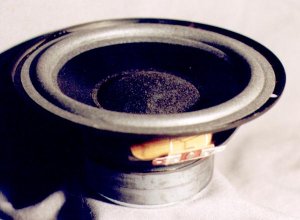 |
 |
| SPEAKERS | ||
| QUESTIONS OR COMMENTS | ||
 |
AUTHOR: | Roman M. Luz III |
| E-MAIL: | luzman@mit.edu | |
| COURSE: | 2 | |
| CLASS/YEAR: | 2 | |
MAIN FUNCTIONAL REQUIREMENT: Convert electric signal into audible sound.
DESIGN PARAMETER: Loudspeaker (there are other types of speakers . . .)
GEOMETRY/STRUCTURE:
|
|
| Full View of Speaker | Speaker Components |
Typical speaker cones range from 1.5 to 18 inches in diameter. Speakers of this size can consume from 0.25-250 Watts (W), resonate at a frequency of 16-4kHz, and have a sensitivity level of up to 95 Decibels (dB)
| Magnet Structure -- Two pieces of oppositely oriented magnets that produce a radial field from the inner to outer magnet | |
| Voice Coil -- Carries the current so that it is always moving in a plane perpindicular to the magnetic field; thus the force always acts on the same axis | |
| Spider -- Vibrates rigidly with the voice coil and translates the mechanical energy to the cone | |
| Cone -- Produces pressure waves from its surface due to the oscillation of the spider | |
| Basket -- Holds the components together firmly, preventing motion in parts like the magnet structure | |
| Dust Cap -- Protects the cone and circuitry from dust . . . a clean speaker is a happy speaker :) |
EXPLANATION OF HOW IT WORKS/ IS USED:
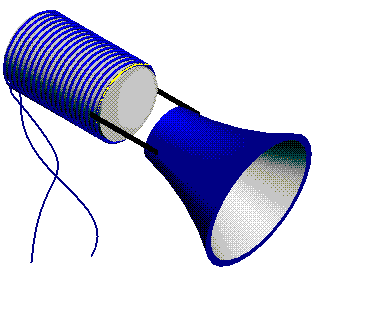 **The waves propagating from the cone seen here only represent sound waves (real sound waves do not look like these) |
| Animation of Speaker Operation |
- The electric signal passes through the wire in the form of an analog, sinusoidal (or other) wave
- The signal enters the voice coil, wrapping around the inner magnet (in the form of a solenoid)
- A force is exerted from the stable magnet structure to the free-moving voice coil
- As the signal's amplitude and frequency change, the force on the voice coil undulates back and forth
- The voice coil rapidly vibrates along the axis of the magnet structure, thereby vibrating the cone
- As the voice cone vibrates, the air immediately around it is pressurized and rarified.
- The pressurized air molecules propagate as a wave -- this is sound
DOMINANT PHYSICS:
| Variable | Description | Metric Units | English Units |
| Pin | Electric Power in wires | Watts | Horsepower |
| Pout | Acoustic Power in sound wave | Watts | Horsepower |
| Ploss | Power loss (in circuits and air) | Watts | Horsepower |
| V | Voltage difference across the voice coils | Volts | Volts |
| i | Current in coils | Amperes | Amperes |
| B | Magnetic Field | Farads | Farads |
| Fmechanical | Force exerted on the voice coil by the magnetic field | Newtons | lbf |
| vc | Velocity of voice coil | m/s | mph |
| Dp | Pressure difference across sound wave | Pascals | lbf/in2 |
| A | Area of pressure wave | m2 | ft2 |
| vw | Velocity of pressure wave | m/s | mph |
| h | Efficiency | --- | --- |
The speakers are powered by entering current and voltage:
Pin = V i
**All speakers use amplifiers to
add more current to the signal to produce louder sound
**i is a function of time, i(t), whose average value is its
maximum amplitude divided by the square root of two
The constant magnetic field acting on this current produces a force on the voice coil:
F = i x B
The force accelerates the voice coil and the power is converted to mechanical power:
F = m a = m dvc/dt
P = F vc
The coils vibrate the cone, which produces a pressure wave that carries the acoustic power:
F = p A
Pout = vw A Dp
or, another way of looking at the power exiting the system is:
Pout = Pin - Ploss = hPin
**This is from the definition for efficiency
AMPLIFIERS
Amplifiers are needed to boost the current source because the current originally carrying
the signal
SIGNALS
The way a signal corresponds to a sound is through its frequency and amplitude. The
frequency relates to how fast the cone oscillates. A high frequency
LIMITING PHYSICS:
EFFICIENCY
Loudspeakers are incredibly inefficient. They can only convert 0.5% to 2% of the power they consume
into acoustic power. Most of the energy lost is given off as heat emanating from the
voice coil and other electric circuits inside the speaker. In particular, one group
of circuits,
called the crossover, dissipates a large percent (how much?) of the energy. The crossover is comprised of capacitors,
resistors, and inductors, and it has the function of sending high frequency signal to the
tweeter and low frequency to the woofer. All of these circuit components take some
electric power and convert it to heat.
PLOTS/GRAPHS/TABLES:
None Submitted
WHERE TO FIND SPEAKERS:
Everywhere! They are all around us -- in our TV's, computers, alarm clocks, cars,
stereos, headphones, etc.
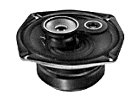 Car speakers |
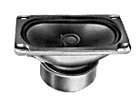 TV speakers |
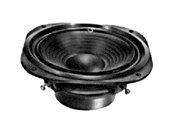 General speakers |
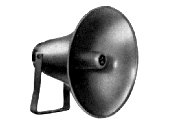 Horn speakers |
REFERENCES/MORE INFORMATION:
Interview: Niels Braroe, MIT Lecturer, January 13,
5:30PM, in the MIT Hobby Shop
Interview: Noah Bray-Ali, MIT
Physics Major, January 12, 6:00PM, in Alpha Delta Phi fraternity of MIT
Electroacoustics: Microphones, Earphones, and Loudspeakers; Gayford, M. L.; American
Elsevier Publishing Company Inc., New York 1971
LINKS Complete Computer Solutions
How to Make Loudspeakers
ELECTROSTATIC LOUDSPEAKERS
Electrodynamic Loudspeakers
